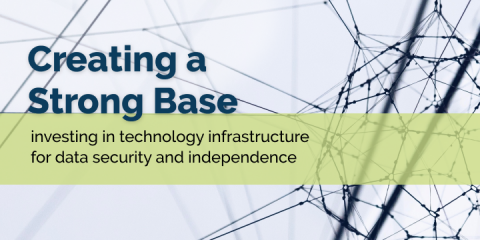Creating a strong base

Scott Wiyninger, SUCCESS Computer Consulting, Inc.
Investing in technology infrastructure for data security and independence
About seven years ago, The Phoenix Residence made the decision to invest heavily in new technology when they transitioned from paper records to electronic processing for items like medication, payroll, and scheduling.
Their new technology investments not only freed up resources to assist in handling some workforce issues that are common in the disability services industry, but also had the added benefit of allowing their residents to utilize assistive technology devices powered through Wi-Fi to increase independence.
Securing the data
In moving from paper to electronic medical records, The Phoenix Residence knew certain precautions would need to be put in place to protect individuals’ privacy. “Certainly, our exposure has increased, because we’re now doing so much of our work through an electronic mechanism,” noted Alan Berner, VP of Community Services.
For facilities that process electronic medical records, certain measures need to be accounted for to ensure only the proper people have access to this sensitive data. How is this done? For The Phoenix Residence, they beefed up their data security infrastructure to ensure the proper level of security. They worked with our team to deploy firewalls throughout their 19 Minneapolis care facilities that were further reinforced by an additional layer of security services that stop malicious software (Malware) from gaining access to their system.
Adding access
As with most organizations, a stable and strong Wi-Fi network was very important to The Phoenix Residence as their staff utilize mobile devices for documenting care needs and medications. To help with this, additional Wi-Fi access points were installed to ensure a strong signal. These additional access points also allowed The Phoenix Residence to provide more extensive wireless coverage for the people they support—opening the door for greater independence through technology use.
“With the wireless access points, though we added them for business operations, there was a side benefit of being able to provide more extensive wireless coverage for the people we support where there wasn’t before – there’s a huge space for growth in this. For example, one person uses Alexa (Amazon’s digital assistant) for quality of life purposes. She controls her lights with it and even has it read her stories. Without being able to use that device, she could not do those things independently. We’ve been discussing integrating more of these devices in other areas of the residence so that when she’s not in her room, she can still have those functions, and some of the other people in the home would be able to utilize them as well,” said Alan.
Read the full case study prepared by SUCCESS Computer Software for full technology details.
SUCCESS provides managed network support, cloud services, project services, security solutions, CIO services, HIPAA consulting and Microsoft Office 365 migrations. We work with business leaders to ensure technology delivers the best value and is utilized in the most effective way for the success of their business today and in the future.
As a full-service provider of managed IT services, we are a part of your team, using technology as a tool to solve your business challenges, and integrating with your business as if we were a full-time employee. It is our purpose to revitalize the promise of technology — to empower businesses with the best and most appropriate technical infrastructure that enables them to succeed.
—
Has your organization gone through a similar transition? If so, how has technology changed your daily processes or access to additional technology assistance for residents? Let us know about your tech experiences.



